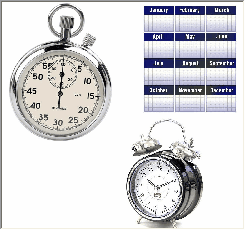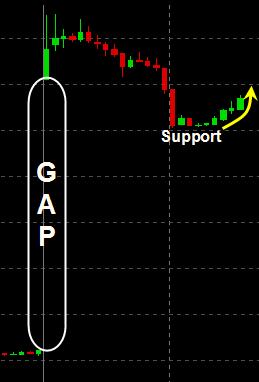Video Review of the Indexes 10-17-2010
October 15, 2010 at 5:07 pm
The bulls posted another solid performance last week as more cash was exchanged for shares. That took the indexes to new recovery highs, but also brought some important resistance areas into play.
The big question on the minds of traders at this point is whether the pace will slow now that resistance from the spring has been reached. We’ll find out soon enough, but there’s still no signs of emerging weakness at this point.
As we head into a brand new week of trading, let’s examine some important levels to keep an eye on in the days ahead. That will have the greatest influence on how individual stocks are going to move, so it’s where the trading week begins.
Be sure to view in full-screen mode for best quality in the video.
Trade Like a Bandit!
Jeff White
Producer of The Bandit Broadcast
Are you following me on Twitter yet?
Video Review of the Indexes 10-10-2010
October 10, 2010 at 8:53 am
The market finished on a strong note last week, reaching new recovery highs after putting in some needed rest. This keeps the uptrends intact, and although resistance zones are quickly approaching, the bulls are showing no signs of concern at this point.
The week ahead is likely to bring a resolution to this short-term indecision, so it’s time once again to check out the big picture for clues of where momentum might return in either direction.
As we head into a brand new week of trading, let’s examine some important levels to keep an eye on in the days ahead. That will have the greatest influence on how individual stocks are going to move, so it’s where the trading week begins.
Be sure to view in full-screen mode for best quality in the video.
Trade Like a Bandit!
Jeff White
Producer of The Bandit Broadcast
Are you following me on Twitter yet?
Trading vs Investing
October 7, 2010 at 11:42 am
 A recent email exchange with a new subscriber brought forth some important concepts I want to share here on the blog. Among this guy’s comments were the following:
A recent email exchange with a new subscriber brought forth some important concepts I want to share here on the blog. Among this guy’s comments were the following:
“I’ve decided to take more control of my money and future after investing for several years with a financial advisor. I’m sitting on a lot of cash..in setting up my portfolio should I scale in and out of some core positions in a separate account? Currently I feel as though I’m under invested, and it sucks to watch undisciplined investors make so much money. I guess the real question is, should I trade my entire account or should I trade some and invest some?”
During any nonstop rally like we’ve seen from the August lows, this is a natural reaction from a trader who has exercised good discipline. Sometimes it seems like it would pay better to just be ignorant and chase extended market moves like this one! Unfortunately though, that’s not an option for anyone who understands the two-sided coin known as risk.
Taking the ‘ignorance is bliss’ mentality may be great on the way up, as every gap higher and afternoon recovery adds to the bottom line. However, when the tide shifts and the tape gets painted red, it’s a recipe for feeling helpless and stupid for not exiting when the opportunity was there.
The Best of Both Worlds
I’m all for people taking control, because many financial advisors simply want to ‘outperform’ the market rather than make money – the only reason to have money in the market to begin with.
Here’s what I personally do with my money in order to benefit from both the short-term fluctuations and the longer-term trends which occasionally emerge…
I like to diversify my timeframes. I don’t trade Bandit setups with all my money, but I do direct all my money. By that I mean nobody else manages it for me. What I do is devote a chunk of it to my short-term trading. I want enough of it available there that no buying power issues arise, and so that I’ll have plenty of cash available to put on any trades I like.
I also take a chunk of money to devote to intermediate-term ideas, so these are plays which I like for the next few months but not short-term or long-term. I’m riding these out with smaller positions, wider stops, and I’ll often exit by way of shorting options against my common.
Finally, I leave money in long-term accounts (retirement accounts) where all I do is trade ETF’s for durations of 6-18 months. Those long-term plays are simply to have market exposure when I feel a big-picture trend is present which I want to be on board for, but do not want to react to every tick. For example, earlier this summer I was buying ETF’s for a bounce, and more recently I’ve been reducing exposure there (by selling to raise cash) and getting called out of those trades after selling calls against those positions.
So for me, dividing funds into different timeframes is really helpful. Also, I maintain separate accounts for these differing timeframes. That means I don’t login to my day trading account and each time see a 6-18month ETF play I’ve been in for 9 months and get tempted to exit after a 30-minute selloff. It is a little more to keep up with, but helps me avoid feeling like I have a lot of cash going unused.
Think of day trading with a stopwatch, swing trading with a clock, and position trading with a calendar. Each can be an effective way to watch the time, and they can all be used simultaneously.
If lately you’re feeling underinvested after this market run, you certainly aren’t alone. It’s a frustrating feeling, but there will be other trends to participate in, and one of these days you’ll be very glad to have cash on hand to put to work.
Any other thoughts?
Trade Like a Bandit!
Jeff White
Producer of The Bandit Broadcast
Are you following me on Twitter yet?
Leadership Has Left the Building
October 6, 2010 at 8:08 pm
I’m not the first one to recognize a big shift in leadership stocks of late, as it seems the momentum train has hit a southbound fork – hard – for several of them.
Stocks which had been running relentlessly higher have turned suddenly. What used to be a buy-on-any-dip mentality associated with them has is now more like sell-all-bounces.
If these truly are ‘leaders,’ then they may be leading to the downside. I’m certainly not one to call for a market peak, as I know momentum can stay present far longer than many expect. However, I will say some other leadership best emerge quickly if the indexes (which are subsequently at big resistance areas) are to continue their relentless pursuit of higher levels.
Let me suggest going full-screen for best quality in the video.
Trade Like a Bandit!
Jeff White
Producer of The Bandit Broadcast
Are you following me on Twitter yet?
5 Rookie Trader Mistakes & How to Avoid Them
October 4, 2010 at 8:50 am
 In trading, as in life, lessons can be learned out of inspiration or desperation. It’s hard to say which is better, but I know that regret is quite a teacher.
In trading, as in life, lessons can be learned out of inspiration or desperation. It’s hard to say which is better, but I know that regret is quite a teacher.
For example, I’m in the process of buying a house right now, which will be the second for my wife and me. Eight years ago, I made several mistakes as a first-time buyer, some of which I’ve wished I could go back and change. Experience educates each of us, fortunately, and needless to say this time around (I think) I’m doing it right.
A lack of experience is responsible for many mistakes newer traders make as well. Those errors not only prove costly the first time around, but they can also ingrain some bad habits if not corrected quickly.
Over the years, I’ve been fortunate to work with hundreds of traders around the globe, of all trading styles and timeframes. And yet as diverse as these traders seem to be, a handful of common issues continue to surface. Coincidence? No. Just human nature, which the market preys upon.
So, to help you stay on the right path with your trading, let’s take a look at 5 common mistakes rookie (or struggling) traders make, and how to avoid them.
1. Adding to Losing Positions. This is a biggie, and it addresses perhaps the most common lapses in judgment among traders of all experience levels. Gartman says to “do more of what is working, and less of what isn’t working.” By definition, a losing position is not working. And unless you originally planned to scale into the trade, adding to a loss is a big no-no. Take note of your P&L, and if you’re wrong, avoid throwing good money after bad.
2. Forcing Trades Out of Boredom. Boredom is one of the biggest enemies of today’s trader, because it leads to so many bad decisions (like overtrading). Transaction costs are so low and it’s so easy to place trades that one can easily forget just how costly boredom trades can become. So if you’ve done your homework and come up with very little, place no pressure on yourself to be active. There are times where sitting tight is exactly what you should be doing, so have the courage and discipline to do nothing when that’s the case.
3. Switching Strategies By the Day. I’m all for trading with multiple strategies, and as your experience increases, your trading toolbelt will begin to fill. However, each of us during times of struggle has encountered the losing streak. That’s perhaps the biggest cause for traders to throw the proverbial spaghetti at a wall to see what sticks. While experimenting can yield some clarity, doing it in either the wrong fashion or too frequently can prove counterproductive. Get some trader training, put some strategies to work across multiple timeframes, and give them enough time to prove their effectiveness. Trying something for a day, losing money with it, and shifting quickly to something else isn’t responsible, so avoid that limited mindset.
4. Putting Everything on the Line for one ‘Idea’ Trade. I was once warned by a more-experienced trader, “don’t get any ideas!” He was right. A longer-term thesis takes time to play out, so leave that to the fundamentalists who don’t mind tying up their capital for months on end – for better or for worse. Stick with what the price action is telling you, and determine the best opportunities to get on board for the next move. Ideas are only useful when they relate to technical discoveries, so don’t bank on guessing right for one big recovery play – it may instead prove to be the final nail in the coffin.
5. Hoping a Stock Will Recover. Each of us has been trapped by a bad trade, and we’ve wondered if sitting motionless and simply hoping to be let out of the trap is the best solution. Marty Schwartz, of Pit Bull fame, mentioned how as a soldier, he was trained to do something when under attack…either fight back or retreat, but don’t just sit there. Hope truly is a 4-letter word in the trading realm, and relying solely on hope will provide plenty of damage to your trading account. Stops are available for good reason. Game plans offer if/then scenarios to follow under the gun so that big decisions need not be made in times of stress or volatility.
Avoid making these mistakes, and your money will be much harder for the pro’s to take.
Trade Like a Bandit!
Jeff White
Producer of The Bandit Broadcast
Are you following me on Twitter yet?
Video Review of the Indexes 10-3-2010
October 3, 2010 at 8:30 am
The major averages put in some much-needed rest last week as they were able to hold above key levels while consolidating. The dips have remained shallow and short-lived since the August lows were set. Although we’re short-term range-bound, it’s difficult to expect that to stay the same given all the movement we’ve witnessed over the past month.
The week ahead is likely to bring a resolution to this short-term indecision, so it’s time once again to check out the big picture for clues of where momentum might return in either direction.
As we head into a brand new week of trading, let’s examine some important levels to keep an eye on in the days ahead. That will have the greatest influence on how individual stocks are going to move, so it’s where the trading week begins.
This clip was also posted over on the Trading Videos site (as always), and perhaps you’ve seen it there – but in case you didn’t, I wanted to put it here on the blog for you.
Let me suggest going full-screen for best quality in the video.
Trade Like a Bandit!
Jeff White
Producer of The Bandit Broadcast
Are you following me on Twitter yet?
One Intraday Setup That’s Working
September 28, 2010 at 9:38 am
In a world dominated by algo’s and machines, the astute trader can still turn a profit. It’s true, despite what many losing traders might tell you.
It takes adaptation, some ingenuity, imagination, and of course, thinking outside the box. For the creative trader though, new patterns will emerge from which profitable trades can be made.
So today, I wanted to point out to you one such example. I won’t name the stock, because it doesn’t matter, but here’s the chart from the opening 50 minutes or so:
As you can see, this stock gapped higher, ran a little more initially, and then began to roll over. The selling intensified as new lows were made on the session, and the gap began to fill before a brief period of rest set in. But that wasn’t the end of the story. Conventional day trading wisdom says this gap keeps getting filled, but only if another new low is made with a break of that intraday support.
Lately I’ve noticed this kind of setup – and you can reverse it with a downside gap if you’d like – offering some good plays. I had one finger on the trigger to short sell this one upon a break of that support, but it held just above the whole number. As the stock started to catch a bid, I went long with a very tight stop – only $0.06 from my long entry. And only 10 minutes later I was flipping out my shares for a quick $0.50 winner.
** For those wondering, that’s a reward-to-risk ratio of better than 8:1.
This setup offers two things I really like…
First, it offers very minimal, defined risk. If support (or resistance in the case of a morning gap down) gives way, I’m out quick for a small loss.
Second, it offers a great pivot area where emotion is building. The battle that took place at support was really something, and once one side began to win out (in this case the buyers), it sparked a quick move away from that level.
So, keep an eye out for this setup – it’s been a great one to trade. Gaps which only partially fill before hesitating at a level just might offer you a quick, profitable reversal play like this one.
Trade Like a Bandit!
Jeff White
Producer of The Bandit Broadcast
Are you following me on Twitter yet?






